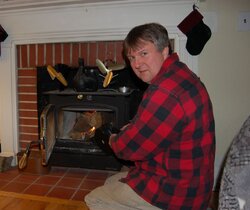Recently, a friend of mine gave me a Dutchwest 264 wood burning stove that he pulled out of one of his rentals. The stove seems to be in fine shape. We want to put this stove in my fireplace and send the venting up through the chimney.
I know there are a variety of ways to do this and that the best way is to have a lined pipe run the entire length of the chimney; however, money is tight. I also know that I can directly vent this stove through the flue with the right type of pipe.
Are there big disadvantages to running a pipe up to the clay tile and not all the way up, assuming I seal off the flue properly and that the chimney is in okay shape?
I've read about possible back puffing. Is that all?
Are there any glaring safety issues that everyone knows but me?
I'd like to get the stove as far back into the fireplace as possible. The vent on this stove goes out the back. Can I just put a 90 degree bend right after the boot and then run pipe right up from there or do a I need a T joint?
Any help would be greatly appreciated.
I live in Kansas City. Winter's are about a 7 out of 10 as far as long cold stretches where I might be using the stove.
I know there are a variety of ways to do this and that the best way is to have a lined pipe run the entire length of the chimney; however, money is tight. I also know that I can directly vent this stove through the flue with the right type of pipe.
Are there big disadvantages to running a pipe up to the clay tile and not all the way up, assuming I seal off the flue properly and that the chimney is in okay shape?
I've read about possible back puffing. Is that all?
Are there any glaring safety issues that everyone knows but me?
I'd like to get the stove as far back into the fireplace as possible. The vent on this stove goes out the back. Can I just put a 90 degree bend right after the boot and then run pipe right up from there or do a I need a T joint?
Any help would be greatly appreciated.
I live in Kansas City. Winter's are about a 7 out of 10 as far as long cold stretches where I might be using the stove.


